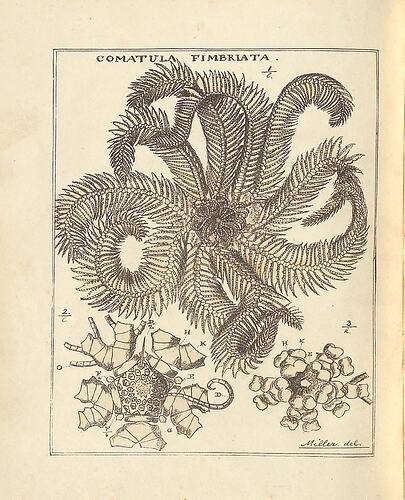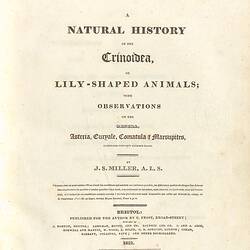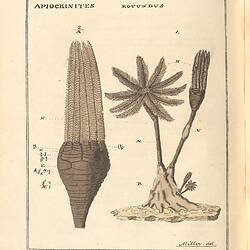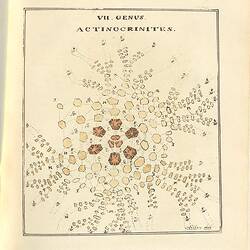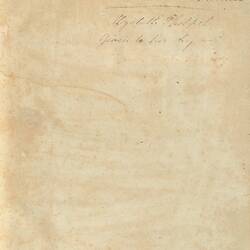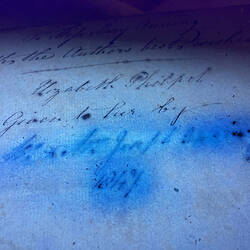In May 2024 Museums Victoria returned a rare book that once belonged to 19th century palaeontologist Mary Anning to the Lyme Regis Museum. J.S. Miller's 'A natural history of the Crinoidea' (1821) was the first modern work on crinoids, a class of marine animals that includes sea lilies and feather stars. The book was held in Museums Victoria's Rare Book Collection between 1985 and 2024.
Mary Anning (1799-1847) is known for her fossil discoveries, which provided evidence that fed into the development of evolutionary theory. She discovered the first ichthyosaur and plesiosaur described in Western science, and the first British pterosaur. Anning was born in Lyme Regis into a working-class family of religious dissenters. Her father was a cabinet maker and amateur fossil hunter, and she went fossil hunting with him from childhood. When he died suddenly in 1810, Anning took to selling fossils from the family's shop to keep the family afloat. Despite persistent financial difficulties she built up a trade in dealing fossils to many prominent scientists and institutions. Through her activities as a fossil collector, she encountered many leading scientists of the day, including John Samuel Miller. Miller visited Lyme Regis in 1824, and may have acquired fossils from Anning during the visit. A number of Anning's fossil specimens were acquired by the Bristol Institution during Miller's time as curator, and the two corresponded directly in 1830 over a fossil fish specimen that she unearthed, named Squaloraia by Henry Riley. Anning correctly identified the fossil as new to science.
'A natural history of the Crinoidea' was given to Anning by Miller between 1821 and 1830, probably in thanks for Anning's fossil collecting work. Working-class Anning owned few books, which were an expensive commodity in this period. Some of her academic acquaintances presented her with copies of their journal articles, while she laboriously made copies of others. When Anning died in 1847, her brother Joseph gave the book to another local fossil-collector, Elizabeth Philpot.
Previous ownership by Anning and Philpot is indicated by the inscriptions found on a free front flyleaf: 'To Miss Mary Anning with the author's best wishes', and beneath the dedication a further inscription that reads 'Elizabeth Philpot / given to her by...' Part of the inscription has been erased through abrasion. Museums Victoria staff recovered the missing text by photographing the page under a UV light, and digitally enhancing the image until the text was just visible. This process revealed that the full inscription reads 'Elizabeth Philpot / given to her by / [Mr & Mrs Joseph Anning / 1847]'.
The work was likely given to Philpot as a memento when Anning died of breast cancer in 1847. The book stayed in the Philpot family until 1929, when it was donated to the Lyme Regis Museum by Miss G Lister.
The book went missing from the Lyme Regis Museum between the 1930s and the 1970s, when the museum suffered a period of decline. Author John Fowles, Honorary Curator at the museum from 1978 to 1988, identified that it was missing when he conducted an audit of the collection. The book was thought missing until 2022, with Anning's biographer Tom Sharpe noting what he thought was the book's last appearance on the market in Bristol in 1983.
Museums Victoria purchased the work from Blackwells in 1985, quite unaware of the link to the Lyme Regis Museum. The work was purchased for scientific research rather than for its association to Mary Anning, although the previous ownership was known and recorded in the catalogue entry.
In 2022, library manager Hayley Webster investigated the erased inscription, and Museums Victoria released a YouTube video documenting the process. This video brought the book to light, and the Lyme Regis Museum made a request for its return.
The book is significant as one of Anning's few remaining material posessions. Although Anning was not forgotten after her death in 1847, the scientific significance of her work often went unacknowledged until recently. Nineteenth century accounts of her tend to be romanticised or misogynistic. For instance, palaeontologist Gideon Mantell described Anning as 'a prim, pedantic vinegar looking, thin female; shrewd, and rather satirical in her conversation.' Past accounts have also exaggerated her lack of education by suggesting that she was barely literate. While she lacked formal education, she could read, and taught herself geology, palaeontology, anatomy and scientific illustration. She was lent her first geology book at 14. Anning's correspondence with various scientists also shows that she actively partook in theoretical debates. As a woman, however, she was unable to join scientific societies, and therefore she operated on the fringe of scientific discourse without receiving proper credit for her work.
Museums Victoria returned the book in May 2024, feeling that it was important for it to reside in Lyme Regis, where Anning's legacy is so significant. The Lyme Regis Museum is built on the site of Anning's first fossil shop, close to the beaches where she made her discoveries.
The book has been digitised and can be accessed via the Biodiversity Heritage Library.
Bibliography
Hutchinson, D. 2021 'The Bristol Institution and Mary Anning, a pioneering palaeontologist', Bristol Museums Blog, 16 April, viewed 14 July 2022, https://www.bristolmuseums.org.uk/blog/the-bristol-institution-and-mary-anning-a-pioneering-palaeontologist/
Hutchinson, D 2021 'That Zealous Naturalist Mr Miller', Bristol Museums Blog, 6 December, viewed 14 July 2022, https://www.bristolmuseums.org.uk/blog/that-zealous-naturalist-mr-miller/
Kammer, T.W. and Ausich, W.I. 2007, 'New cladid and flexible crinoids from the Mississippian (Tournasian, Ivorian) of England and Wales', Palaeontology, vol. 50, pp. 1039-1050, viewed 19 April 2021, https://doi.org/10.1111/j.1475-4983.2007.00694.x
Sharpe, T. 2021 The Fossil Woman: A Life of Mary Anning, Dovecote, Stanbridge, Wimborne Minster, Dorset.
Torrens, H. 1995, Presidential Address: Mary Anning (1799-1847) of Lyme; "The Greatest Fossilist the World Ever Knew", The British Journal for the History of Science, vol. 28, no. 3, pp. 257-284, viewed 19 April 2021, from http://www.jstor.org/stable/4027645
'II. Memoir of the late J. S. Miller, A.L.S. Curator of the Museum of the Bristol Philosophical Institution', 1831 The Philosophical Magazine, 9:49, 4-7, viewed 19 April 2021, DOI 10.1080/14786443108647520
More Information
-
Keywords
-
Authors
-
Article types
